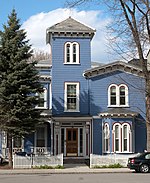Back of the Hill station
Green Line (MBTA) stationsMassachusetts Bay Transportation Authority stubsMassachusetts railway station stubsRailway stations in BostonRailway stations in the United States opened in 1982 ... and 2 more
United States light rail stubsWikipedia page with obscure subdivision

Back of the Hill station is a surface stop on the light rail MBTA Green Line E branch, located in the Mission Hill neighborhood of Boston, Massachusetts. It is named after, and primarily serves, the adjacent Back of the Hill apartment complex, a Section 8 development for elderly and disabled residents. Back of the Hill is located on the street running section of the E branch on South Huntington Avenue. The station has no platforms; passengers wait in bus shelters (shared with route 39 buses) on the sidewalks and cross a traffic lane to reach Green Line trains.
Excerpt from the Wikipedia article Back of the Hill station (License: CC BY-SA 3.0, Authors, Images).Back of the Hill station
South Huntington Avenue, Boston Mission Hill
Geographical coordinates (GPS) Address Nearby Places Show on map
Geographical coordinates (GPS)
| Latitude | Longitude |
|---|---|
| N 42.329386111111 ° | E -71.110961111111 ° |
Address
South Huntington Avenue 101
02120 Boston, Mission Hill
Massachusetts, United States
Open on Google Maps











